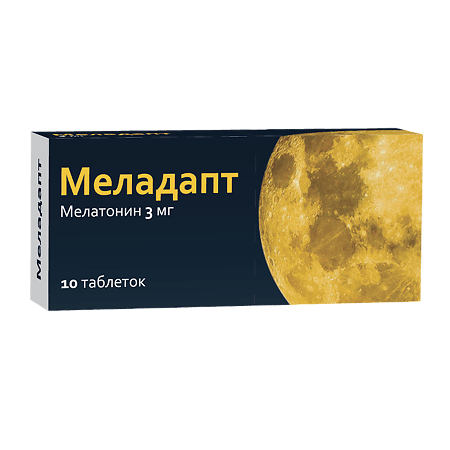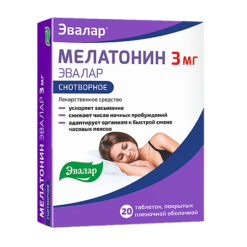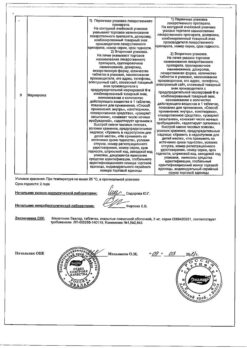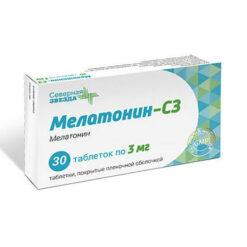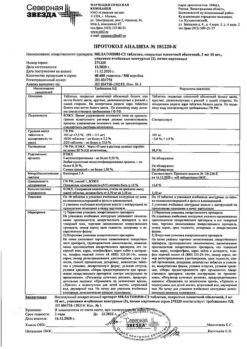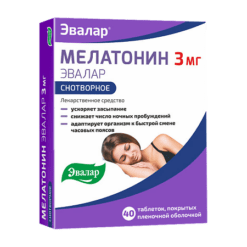No products in the cart.
Meladapt, 3 mg 10 pcs
€8.76 €7.00
Out of stock
(E-mail when Stock is available)
EAN: 4680020183905
SKU: 511295
Categories: Medicine, Neurology and Psychiatry, Sedatives and hypnotics
Description
Pharmacotherapeutic group: adaptogenic agent.
ATX code: N05CN01
Pharmacological properties
Pharmacodynamics
Melatonin is a synthetic analog of the pineal hormone (epiphysis); it has adaptogenic, sedative and hypnotic effects. Normalizes circadian rhythms. Increases the concentration of gamma-aminobutyric acid (GABA) and serotonin in the midbrain and hypothalamus, changes the activity of pyridoxal kinase, involved in the synthesis of GABA, dopamine and serotonin. It regulates the sleep-wake cycle, daily changes in locomotor activity and body temperature, has a positive effect on the intellectual and mental functions of the brain and on the emotional-personal sphere.
It helps to organize the biological rhythm and normalize night sleep. Improves the quality of sleep, speeds up falling asleep and regulates neuroendocrine functions. It adapts the body of people sensitive to changes in weather conditions.
Pharmacokinetics
Absorption
Melatonin is rapidly absorbed in the gastrointestinal tract after oral administration. In elderly patients the rate of absorption may be reduced by 50%. The pharmacokinetics of melatonin in the dose range from 2-8 mg is linear. When administered orally at a dose of 3 mg, the maximum concentration (Cmax) in plasma and saliva is reached after 20 minutes and 60 minutes, respectively. Time to reach Cmax in serum is 60 minutes (normal range 20-90 minutes). After administration of 3-6 mg of melatonin, serum Cmax is generally 10 times greater than endogenous melatonin in serum at night. Simultaneous intake of food decreases the absorption of melatonin.
The bioavailability of melatonin when taken orally ranges from 9 to 33% (approximately 15%).
Distribution
In in vitro studies, the binding of melatonin to plasma proteins is 60%. Melatonin mainly binds to albumin, α1-acid glycoprotein and high-density lipoproteins. The volume of distribution is about 35L. Rapidly distributed in saliva and passes through the blood-brain barrier, determined in the placenta. Concentration in cerebrospinal fluid is 2.5 times lower than in blood plasma.
Metabolism
Melatonin is metabolized primarily in the liver. After ingestion, it undergoes substantial metabolism by “primary passage” through the liver, where it is hydroxylated and conjugated to sulfate and glucuronide to form 6-sulfatoxymelatonin; presystemic metabolism can be as high as 85%. Experimental studies suggest that the CYP1A1, CYP1A2 and possibly CYP2C19 cytochrome P450 isoenzymes are involved in the metabolism of melatonin. The main metabolite of melatonin, 6-sulfatoxymelatonin, is inactive.
Elimation
Melatonin is excreted by the kidneys. The average half-life (T1/2) is 45 minutes. Excretion is by the kidneys, about 90% as sulfate and glucuron conjugates of 6-sulfatoxymelatonin, and about 2% to 10% are excreted unchanged.
Pharmacokinetic parameters are affected by age, caffeine intake, tobacco smoking, taking oral contraceptives. Accelerated absorption and impaired elimination are observed in critical patients.
Special patient groups
Elderly patients
Melatonin metabolism is known to slow with age. At different doses of melatonin, higher values of area under the concentration-time curve (AUC) and Cmax were obtained in elderly patients, which reflects the reduced metabolism of melatonin in this group of patients.
Patients with impaired renal function
There was no cumulation with long-term use of melatonin. These data are consistent with the short T1/2 melatonin in humans.
Patients with impaired liver function
The liver is the main organ involved in melatonin metabolism, so liver disease leads to increased concentrations of endogenous melatonin. In patients with liver cirrhosis, plasma concentrations of melatonin were significantly increased during the daytime.
Indications
Indications
Active ingredient
Active ingredient
Composition
Composition
1 tablet contains:
Active ingredient: melatonin – 3.00 mg.
Associates: calcium hydrophosphate dihydrate – 143.25 mg, microcrystalline cellulose (MCC-102) – 100.00 mg, magnesium stearate – 2.50 mg, croscarmellose sodium – 1.25 mg.
Coating composition: polyvinyl alcohol – 2.70 mg, macrogol-4000 – 1.30 mg, titanium dioxide – 1.00 mg.
How to take, the dosage
How to take, the dosage
To be taken orally.
In disordered sleep 1 tablet (3 mg) 30-40 minutes before sleep, once a day.
In desynchronosis as an adaptogen when changing time zones – 1 day before the flight and in the next 2-5 days – 1 tablet 30-40 minutes before sleep.
The maximum daily dose is 2 tablets (6 mg).
Application in special groups of patients
Elderly patients (over 65 years)
.p> Melatonin metabolism decreases with age, which should be considered when choosing a dosing regimen in elderly patients.
In view of this in elderly patients it is possible to take Meladapt 60-90 minutes before sleep.
Kidney function disorders
The effect of different degrees of renal impairment on the pharmacokinetics of melatonin has not been studied, therefore Meladapt should be taken with caution in patients with mild to moderate renal impairment. The drug is contraindicated in patients with severe renal impairment (CKR less than 30 ml/min) (see section “Contraindications”).
Interaction
Interaction
Pharmacokinetic interaction
Melatonin is known to induce the CYP3A isoenzyme under in vitro conditions at concentrations significantly greater than therapeutic. The clinical significance of this fact is not fully known. If signs of induction develop, consideration should be given to reducing the dose of concomitantly administered drugs.
Melatonin does not induce CYP1A isoenzymes at concentrations significantly higher than the therapeutic ones under in vitro conditions. Therefore, the interaction of melatonin with drugs, due to the effect of melatonin on CYP1A isoenzymes, appears to be insignificant.
The metabolism of melatonin is mainly mediated by CYP1A isoenzymes. Therefore, melatonin may interact with other medications due to the effect of melatonin on CYP1A isoenzymes.
Patients should be cautious about those taking fluvoxamine which when used concomitantly with melatonin increases its plasma concentrations (17 fold AUC and 12 fold Cmax) due to inhibition of its metabolism by the CYP1A2 and CYP2C19 cytochrome P450 isoenzymes. Concomitant use should be avoided.
Patients taking 5- and 8-methoxypsoralen, which increase plasma concentrations of melatonin due to inhibition of its metabolism, should be treated with caution.
Patients taking cimetidine (CYP2D isoenzyme inhibitor) should be treated with caution because it increases melatonin plasma concentrations due to inhibition of the latter.
Tobacco smoking reduces the plasma concentration of melatonin by inhibiting the CYP1A2 isoenzyme.
Cautions are required in patients taking estrogens (e.g., contraceptives or hormone replacement therapy), which increase plasma concentrations of melatonin due to inhibition of their metabolism by CYP1A1 and CYP1A2 isoenzymes.
Inhibitors of CYPA2 isoenzyme, such as quinolones, can increase melatonin exposure when used simultaneously.
Inducers of the CYP1A2 isoenzyme, such as carbamazepine and rifampicin, can decrease the plasma concentration of melatonin when used simultaneously.
Many studies have been published in the literature regarding the effects of adrenergic and opioid receptor agonists/antagonists, antidepressants, prostaglandin inhibitors, benzodiazepines, tryptophan and ethanol on endogenous melatonin secretion. No studies have been conducted on the possible interaction of these drugs on the pharmacodynamics and pharmacokinetics of melatonin.
Pharmacodynamic interaction
Ethanol when used concomitantly with melatonin reduces its effectiveness.
Meladapt potentiates the sedative effects of benzodiazepine and non-benzodiazepine sleeping pills such as zaleplon, zolpidem and zopiclone.
In a clinical study, there was clear evidence of transient pharmacodynamic interaction between melatonin and zolpidem 1 hour after their administration. Simultaneous use may lead to progressive impairment of attention, memory and coordination compared to zolpidem monotherapy.
In clinical studies, melatonin has been used concomitantly with thioridazine and imipramine, medications that affect the central nervous system. No clinically significant pharmacokinetic interactions have been identified in any case. However, concomitant use with melatonin resulted in an increased sense of calmness and difficulty performing certain activities compared with imipramine monotherapy, as well as an increased sense of “blurring in the head” compared with thioridazine monotherapy.
Special Instructions
Special Instructions
During the use of the drug Meladapt it is recommended to avoid being in bright light.
Women planning pregnancy should be informed about the weak contraceptive effect of the drug.
There is no clinical data on the use of melatonin in patients with autoimmune diseases; therefore, the drug is not recommended for this patient group (see Contraindications section).
When using Meladapt, do not drink alcohol, which decreases its effectiveness.
Melatonin metabolism decreases with age; this must be considered when choosing a dosing regimen in elderly patients (see section “Dosage and administration”).
Influence on driving and operating ability
. When using the drug Meladapt it is necessary to refrain from driving vehicles and engaging in potentially hazardous activities requiring increased concentration and rapid psychomotor reactions (risk of drowsiness).
Synopsis
Synopsis
Contraindications
Contraindications
Hypersensitivity to melatonin and other drug components, severe renal impairment (creatinine clearance less than 30 ml/min) autoimmune diseases (no clinical data available), hepatic failure, pregnancy and breastfeeding, age under 18 years (effectiveness and safety not established).
With caution
Kidney failure (CK greater than 30 mL/min), advanced age.
Side effects
Side effects
The side effects are systematized for each of the organ systems according to frequency of occurrence using the World Health Organization classification: very frequently (>1/10), often (>1/100), infrequently (>1/1000, <1/100), frequently(>1/10000, <1/1000), very rarely (<1/10000, including isolated cases), frequency unknown (insufficient data to estimate incidence).
Infectious and parasitic diseases: frequent herpes zoster.
Disorders of the blood and lymphatic system: frequent leukopenia, thrombocytopenia.
Disorders of the immune system: frequency unknown – sensitivity reactions.
Disorders of metabolism and nutrition: rarely – hypertriglyceridemia, hypokalemia, hyponatremia.
Mental disorders: infrequent – irritability, nervousness, restlessness, insomnia, unusual dreams, nightmares, anxiety; frequent – mood swings, aggression, agitation, tearfulness, stress symptoms, disorientation, early morning awakening, increased libido, lower mood, depression.
Nervous system disorders: frequent – migraine, headache, lethargy, psychomotor hyperactivity, dizziness, somnolence; frequent -fainting, memory disturbance, impaired concentration, delirium, restless legs syndrome, poor sleep quality, paresthesia.
Visual disorders: rare – decreased visual acuity, blurred vision, increased lacrimation.
Hearing organ and labyrinth disorders:rarely – vertigo, positional vertigo.
vascular disorders: infrequent – increase in blood pressure; seldom – “rushes” of blood to the face.
Cardiac disorders: frequently – angina pectoris, palpitations.
Gastrointestinal tract disorders: infrequent abdominal pain, upper abdominal pain, dyspepsia, ulcerative stomatitis, dry mouth, nausea; frequently- gastroesophageal disease, gastrointestinal disorders or disorders, bullous stomatitis, ulcerative glossitis, vomiting, increased peristalsis, abdominal bloating, hypersecretion of saliva, bad breath, abdominal discomfort, gastric dyskinesia, gastritis.
Liver and biliary tract disorders: not infrequently – hyperbilirubinemia.
Skin and subcutaneous tissue disorders: infrequent – dermatitis, increased sweating at night, skin itching and generalized itching, skin rash, dry skin; frequently – eczema, erythema, hand dermatitis, psoriasis, generalized rash, itching rash, nail lesions; frequency unknown- angioedema (Quincke’s edema), oral mucosal edema, tongue edema.
Muscular and connective tissue disorders: frequently – pain in the extremities; frequently – arthritis, muscle spasm, neck pain, night cramps.
Kidney and urinary tract disorders: frequent -glucosuria, proteinuria; frequently – polyuria, hematuria, nycturia.
Renital and mammary gland disorders: infrequent – menopausal symptoms; frequently – priapism, prostatitis; frequency unknown – galactorrhea.
General disorders and disorders at the site of administration: infrequent – asthenia, chest pain; frequently – increased fatigue, pain, feeling of thirst.
Laboratory and instrumental findings: frequent – deviation from normal laboratory indicators of liver function, increased body weight; frequently – increased activity of “hepatic” transaminases, deviation from normal blood electrolyte content, deviation from normal results of laboratory tests.
If you get any of the side effects mentioned in the leaflet, or if they get worse, or if you notice any other side effects not mentioned in the leaflet, tell your doctor.
.
Overdose
Overdose
Symptoms
The use of melatonin at daily doses up to 300 mg has not caused clinically significant adverse reactions according to published data. Hyperemia, abdominal cramps, diarrhea, headache, and scotoma have been observed when melatonin doses of 3000 to 6600 mg have been used for several weeks. Involuntary loss of consciousness has been observed with very high doses of melatonin (up to 1 g).
In overdose, somnolence may occur.
Treatment:Gastric lavage and administration of activated charcoal, symptomatic therapy. Clearance of the active substance is expected within 12 hours after ingestion.
Pregnancy use
Pregnancy use
Pregnancy
There are no data on the effect of melatonin on pregnancy.
The use of Meladapt during pregnancy and in women planning to become pregnant is not recommended.
Breastfeeding
Because endogenous melatonin is detected in breast milk, it is likely that exogenous melatonin may also pass into breast milk.
Breastfeeding should be stopped if Meladapt is to be used during lactation.
Similarities
Similarities
Additional information
| Shelf life | 3 years. Do not use after the expiration date. |
|---|---|
| Conditions of storage | At a temperature not higher than 25 ºC. Keep out of reach of children. |
| Manufacturer | Ozon, Russia |
| Medication form | pills |
| Brand | Ozon |
Other forms…
Related products
Buy Meladapt, 3 mg 10 pcs with delivery to USA, UK, Europe and over 120 other countries.

